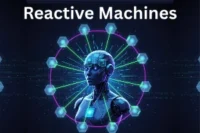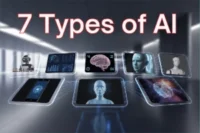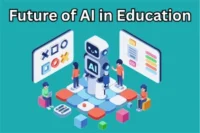AI for Beginners: Simple Guide to Understand Artificial Intelligence
Published: 19 Sep 2025
Artificial Intelligence, or AI for beginners, may sound difficult, but it’s already part of your daily life. AI is everywhere, prompting Alexa to play music and then suggest a movie on Netflix. Have you ever wondered how machines can think and learn like human beings? It certainly means that AI collects data, analyzes the patterns, and makes informed decisions.
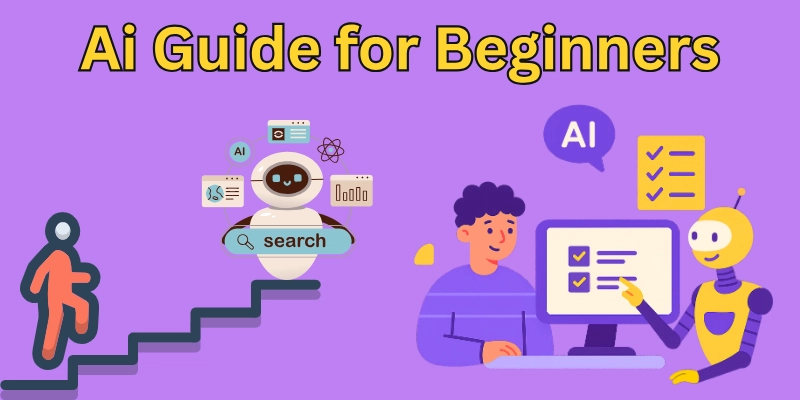
In this article, we will break down AI for beginners with simple words, real examples, and simple stages so you understand how it works and why it means something today.
What Is AI?(Beginner-Friendly)
Artificial Intelligence (AI) is when computers are designed to act and learn like humans.
Instead of just following certain instructions, AI can analyze the system information, find patterns, and create an alternative on its own. For example, using a chatbot that answers your questions or a self-driving car that recognizes traffic signals, AI. With simple words, it is the technique that helps machines “think”, solve problems, and improve over time without each step.
History of AI for Beginners
Artificial intelligence has increased for decades, and changed with a simple idea in today’s powerful technology. From early principles to machines that can exclude people in sports, AI’s journey is full of exciting successes.
Key points:
Here are some Key points about the history of AI (Artificial Intelligence)
- AI research started in the 1950s to think of machines as humans.
- In the 1980s, expert systems marked the first practical use of AI.
- In the 2000s, the successes of machine learning AI pushed new levels.
- IBM’s Deep Blue defeated chess champion Gary Kasparov, which turned out to be AI’s ability.
Types of AI (Artificial Intelligence)
Here are the main types of AI explained in a simple one-point:
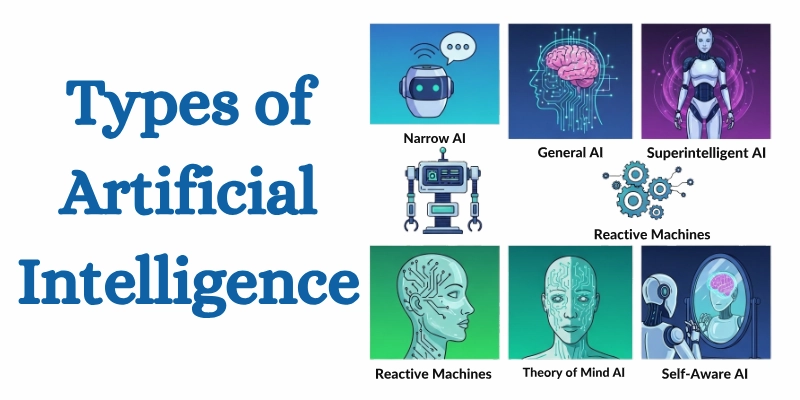
- Reactive Machines: Basic AI that responds to conditions without memory (such as Deep Blue of IBM).
- Theory of Mind AI: A future AI concept that can understand human feelings and intentions.
- Self-Aware AI: An advanced idea where AI knows that its existence is also in principle.
- Narrow AI (weak AI): Designed to perform a specific function, such as voice assistants or chatbots.
- General AI (strong AI): a continued uncontrolled AI that can think and learn as a human in many tasks.
- Superintelligent AI: A thought future AI that can overcome human intelligence in all fields.
How AI (Artificial Intelligence) Works
AI may sound difficult, but there is a clear process for learning and decision-making. Here is a simple guide:
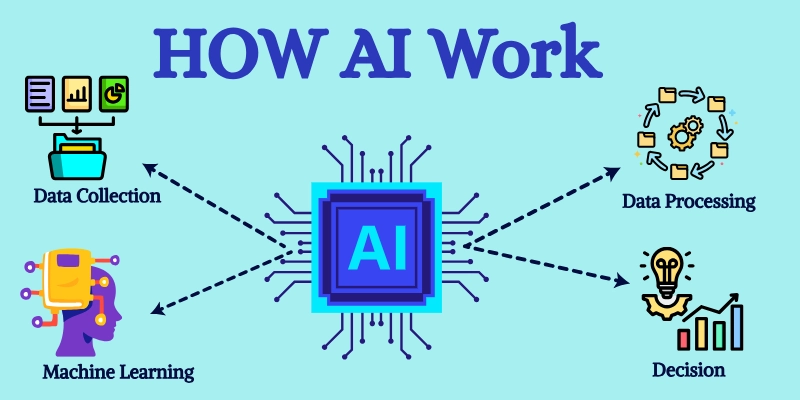
- Data collection: AI collects a lot of information, such as images, lessons, or numbers, to learn patterns.
- Data preparation: The collected data is cleaned and organized so that AI can understand it easily.
- Model training: The machine learning algorithm teaches AI to detect patterns and provide predictions.
- Testing and evaluation: The trained model is checked with new data to determine how well it works.
- Provision: When AI is ready, AI uses your learning to respond or take action, such as recognizing a cat in an image.
- Continuous improvement: AI learns from new data to become smarter and more accurate over time.
- Tip: Start with small projects, such as image or text recognition, to see how these phases work in action.
Everyday Uses of AI for Beginners
AI is part of our daily lives, and often focuses on us without us. Here are some simple examples:
- Smartphone: Voice assistant acts as Siri or Google Assistant, and Future Texts are sent quickly.
- Online services: Search engines and shopping sites provide personal suggestions.
- Healthcare: AI helps doctors detect diseases quickly with image analysis and computer tracking.
- Finance: Banks use AI to watch scams and protect their money.
- Transport: Apps that Google Maps uses AI to suggest the fastest routes.
- Entertainment: Streaming platforms like Netflix recommend shows based on what you watch.
- Tip: Note that these tools save time and simplify everyday decisions – you’ve already tried without using AI!
Simple Steps of AI for Beginners
AI may sound difficult, but it actually learns like we do, through observation, practice, and improvement.
- Step 1: Collect information, such as multiple pictures or words.
- Step 2: Show these pictures or words to the computer repeatedly so that it can learn.
- Step 3: Test the computer to see if it has learned well. If it makes a mistake, help learn it again.
- Step 4: Use new skills to help people, for example, suggest songs or help doctors find problems in X-rays.
- Example: Think about talking to voice assistants like Siri or Alexa. After learning from thousands of voices, AI can understand what you say and answer your questions.
Benefits of AI for Beginners
AI is like a super helper that makes our work easy. It has some advantages you should know:
| Advantages of AI for Beginners |
|---|
Here are some benefits of AI for beginners, simple ways it helps:
|
Drawbacks of AI (Easy to Understand for Beginners)
AI is helpful in today’s digital world to make work easier, but it also has some downsides you should know:
| Disadvantages of AI for Beginners |
|---|
Here are some drawbacks of AI for Beginners
|
How Beginners Can Start Learning AI
AI may look big, but you can start small and have fun:
- Watch free videos on YouTube: Learn the basics with short, simple lessons.
- Try simple coding in Python: Practice with a teacher or use beginner-friendly tutorials.
- Make a fun mini project: For example, make a simple chatbot that can respond to Hello messages.
- Join the children’s coding club: Learn and share ideas with friends when making projects together.
Future of AI for Beginners
AI will be a big part of everyday life:
- Helpful Robots: They can assist with work at home or support doctors in hospitals.
- Self-driving cars: Cars that drive themselves will become more common on the streets.
- Better learning and work: AI will make school projects easier and help people in their jobs.
- More fun tools: From smart games to creative apps, AI will bring new ways to play and create.
Amazing facts about AI for Beginners
Artificial Intelligence (AI) is full of amazing surprises. Here are some fun and easy facts beginners will enjoy!
- AI can translate languages in seconds, such as converting English to Spanish immediately.
- Some AI programs can create pictures and even write small stories.
- AI helps doctors find diseases than before.
- Voice assistants like Alexa or Siri consider what you say and respond.
- Self-driving cars use AI to “see” the way and avoid accidents.
- AI can detect patterns in large data that people can miss.
- A robot with AI can learn new tasks, just like students in school.
- AI helps suggest movies or songs you might like on Netflix or Spotify.
Conclusion
Therefore, in this article, we have covered AI for beginners in detail. I recommend starting with small free videos, trying a simple project like a chatbot, or learning basic equipment like Python. Take it step by step and don’t hurry, because AI is powerful and understands that it is good to help you avoid mistakes like using incredible data or forgetting privacy. Continue to search and be curious; you might be the one shaping the future of AI. Start now, do something fun, and share your work to inspire others to join this wonderful journey!
FAQs
Here are some interesting FAQs about AI for beginners, so you understand every point easily.
AI (Artificial Intelligence) is when computers learn to think or act like humans. They can recognize patterns, answer questions, or make decisions. For example, a voice assistant like Siri can understand what you say and respond.
No, you can begin with simple concepts and learn math later as you grow. Many beginner courses explain AI without hard formulas. Start with basics like how machines learn from data.
AI is the big idea making machines smart. Machine learning is a part of AI where computers learn from examples. Think of AI as the “brain” and machine learning as a “skill” it uses.
Yes! You can start with small projects like a chatbot or a simple image recognition game. Free tools like Google Teachable Machine make it easy without coding.
Don’t rush into complex projects too soon. Start small and use trusted learning resources. Also, be careful with personal data to stay safe.
AI can change some jobs, but also creates new ones. Learning basic AI skills will help you stay ready for future careers. It’s more about adapting than being replaced.
With a few hours each week, you can learn the basics in 2 or 3 months. The key is steady practice and curiosity. Start with free online videos or beginner-friendly courses.
Not at the start. You can first understand how AI works using simple tools. Later, learning Python can help you build your own projects.
AI learns from data, so if the data is incorrect or incomplete, mistakes happen. It doesn’t “think” like humans; it follows patterns. Always double-check AI’s output.
Begin by watching beginner videos or reading simple guides. Try a small project like teaching a computer to recognize pictures. This hands-on practice makes learning fun and easy.

- Be Respectful
- Stay Relevant
- Stay Positive
- True Feedback
- Encourage Discussion
- Avoid Spamming
- No Fake News
- Don't Copy-Paste
- No Personal Attacks

- Be Respectful
- Stay Relevant
- Stay Positive
- True Feedback
- Encourage Discussion
- Avoid Spamming
- No Fake News
- Don't Copy-Paste
- No Personal Attacks


